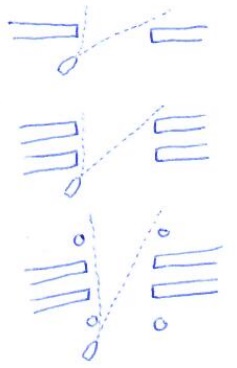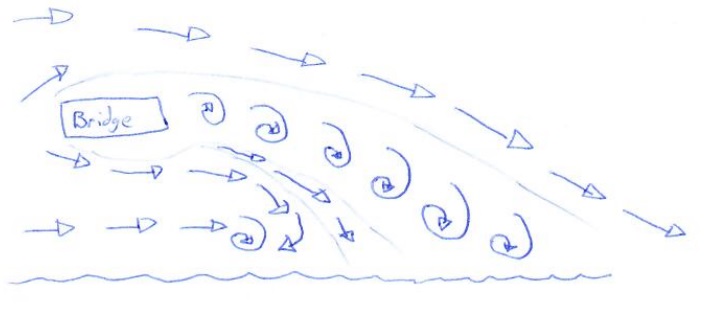When you think of sailing, you probably imagine open waters all the way to the horizon! While that is where we all like to sail off to, sometimes you need to sail through some rather cramped passes to get out to these open waters.
Two common narrow passes that will present themselves are bridges and channels. Both of these offer restricted amounts of water to move through, while bridges also offer disturbances to the wind.
I am going to focus on sailing through a bridge pass because it is easier to visualize and also trickier than sailing through channel. Channels have steady winds and underwater walls (usually) marked by buoys, while bridges have squirrely winds and the walls are marked by large visible pilings. Due to the added complexity of a bridge pass, I will focus on them as all this information is easily transferred to the channel pass.
The difficulties of sailing through a bridge pass are:
Narrow waterway
Not enough room to tack
Shifting winds
Boat traffic
Obviously, the pass is going to be narrow. While some large bridges have a horizontal span of 1000 feet, this may still feel tight. Single bridges are not a serious problem, all you need to do is clear the pilings and you are free and clear of the obstruction. Divided highway bridges pose more difficulty to sail through.
The single bridge offers a wide opening and not much length to the pass, pretty much any tack will be able to get you through this pass.
The double bridge still offers the same width of opening, but the length of the pass has been increased, restricting the angle that you can sail through the pass on.
The double bridge with abutments pose additional challenges. The width is the same as in the other two examples, but the length of the pass has been drastically increased. If you were to sail at the same angle as a single or double bridge, you would end up colliding with the pilings or abutments. This greatly reduces the angle you can safely sail through the pass.
Large bridges tend to have these concrete abutments along the pass to protect the bridge pilings from collision. This means that large bridges with long passes will have added length in the form of collision abutments.
As you can imagine, most of these large bridges with protective abutments are also highly trafficked areas, so the narrow sailing angle is further reduced by cargo ship traffic (which has right of way over a sailboat under sail due to their reduced maneuverability and restriction by draft).
Some real life examples are the Francis Scott Key Bridge and the Chesapeake Bay Bridge in Annapolis. Both of these are busy passes that feel rather tight at times.
Scott Key 1100 feet wide
Bay Bridge 1500 feet wide
As you can see, the passes are 1100 and 1500 feet wide, but due to abutment and double roadways, they can feel much tighter and pose a considerable challenge.
Naturally, the easiest way to sail through these bridges is on a run. This provides a straight course right down the middle of the bridge, clearing all obstructions with ease! If the prevailing winds have you on a run as you go through the bridge, that means that you will have to tack through them on your way back.
The next best wind direction is for the wind to be blowing with the bridge, allowing you to sail through it on a beam reach. This will also allow for a straight passage through the bridge in both directions. When sailing through the pass, stay to the windward side of the pass, this way if you have to fall off, you will have plenty of seaway to leeward. If you are cutting it close on the leeward side, any change in the wind can lead you into a collision with the obstructions.
Lastly, the hardest way to navigate a bridge pass is when beating into it. You need to perfectly time your tacks so that your course will set you through the pass, clearing all the obstructions on a single tack. If you are on a port tack, you need to enter on the left leeward corner, cross the entire pass, and exit on the right windward corner.
This is an ideal course to take while traversing the pass. If you tack right on your mark, you might drift to leeward a little bit, forcing you to carry out two additional tacks to get through the pass.
The other difficulty posed by a windward bridge is the wind shadow cast by structure.. Wind shadows can be massive! They extend twice as high as the structure creating the block, and 20x as long as the structure is high. This means that a bridge 200 feet tall can cast a wind shadow 4000 feet away!
As you approach the bridge, you will feel the wind die down, change direction, and then go back to normal. When running through a bridge, accidental jibes can happen out of no where. When beating through a bridge, it is best to overshoot your tack that way you wont be forced to carry out more tacks to compensate for a navigational error caused by the wind shifts.
When you have a double roadway, the winds become even more complicated. The air in between the two bridges can be very confusing and trying to pinch your way through can be very tricky!
Dealing with ship traffic only adds to the complexity. Large commercial vessels have right of way over a sailboat under sail when navigating within the channel. This means that you have to line yourself up to cross through the narrow pass and time it perfectly so you are out of the way of the commercial ship traffic. While you may see them, they probably can't see you! If they do see you, they also assume that you will get out of their way to avoid a collision. This can lead to aborted attempts to cross the bridge pass which can be a frustrating.
If you begin to get frustrated trying to get through the bridge pass, just remember this:
The winds will change.
If you spend several hours trying to get through a pass because the winds are not favorable, they will probably change to a more favorable direction. This means that you can either struggle for a few hours until the winds change or heave-to, have some lunch, and try again later!
Just remember to always have an exit route. In mountain biking, we call it a "chicken route". As you approach an obstacle, if you get scared you can change direction and go around it instead of over it. We call it a "chicken route" because you chickened out and bailed on the obstacle. In sailing, the "chicken route" is simply a quick exit that will get you out of a tight situation.
If you are tacking through a bridge pass and find yourself on a collision course with a piling, try to pinch. If you stall out, try to tack. If that doesn't work and you find yourself stalled out and drifting towards a piling, jibe around and run right out of there to try again. This is your chicken route!
You must always maintain a clear exit that you can safely and quickly take to get out of a tight situation. As long as you always maintain a chicken route, you will find yourself feeling more secure in your maneuvers, no matter the conditions.
Lastly, if you are trying to cross a narrow pass and there is no boat traffic, you can always kedge across. To do this, you need to row an anchor and warp line to the other side of the pass. Dump the anchor over and let it set, then row back to the boat and begin taking in the line. The anchor will offer a secure point to pull the boat towards, pulling you right through the narrow pass. Obviously, any form of traffic will pose a hazard as the warp line can foul a prop. Once on the other side, raise the anchor and sail on!
The limitations to this method involve the length of warp line you have on hand. If the pass is longer than your line, you will have to use multiple anchors and multiple warp lines. This method is very time consuming and slow, which accounts for why it is rarely done. This method would shine if you need to get through a very narrow pass with wind or current coming directly at you. It would not be possible to sail through something like this, so the kedge anchor will reign supreme!
If there is no current or wind, towing the sailboat with the dinghy or sculling the yacht through the pass would also prove to be easier than setting a kedge anchor. At the end of the day, you must ask yourself "How badly do I want to get over there?"
If it's not worth the effort, maybe sail off to an easier place to enter. On the other hand if the creek is that hard to get into, it will be you might be the only one in there!










